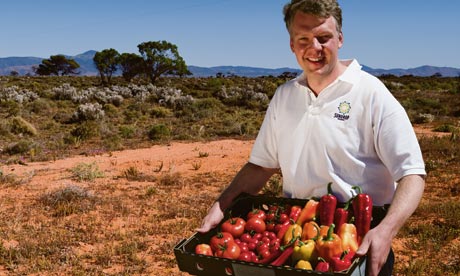Philipp Saumweber is creating a miracle in the barren Australian outback, growing tonnes of fresh food. So why has he fallen out with the pioneering environmentalist who invented the revolutionary system?

Desert blooms: Philipp Saumweber, the founder and CEO of Sundrop, with a tray of his “perfect” produce. Photograph: Jonathan Margolis for the Observer
The scrubby desert outside Port Augusta, three hours from Adelaide, is not the kind of countryside you see in Australian tourist brochures. The backdrop to an area of coal-fired power stations, lead smelting and mining, the coastal landscape is spiked with saltbush that can live on a trickle of brackish seawater seeping up through the arid soil. Poisonous king brown snakes, redback spiders, the odd kangaroo and emu are seen occasionally, flies constantly. When the local landowners who graze a few sheep here get a chance to sell some of this crummy real estate they jump at it, even for bottom dollar, because the only real natural resource in these parts is sunshine.
Which makes it all the more remarkable that a group of young brains from Europe, Asia and north America, led by a 33-year-old German former Goldman Sachs banker but inspired by a London theatre lighting engineer of 62, have bought a sizeable lump of this unpromising outback territory and built on it an experimental greenhouse which holds the seemingly realistic promise of solving the world’s food problems.
Indeed, the work that Sundrop Farms, as they call themselves, are doing in South Australia, and just starting up in Qatar, is beyond the experimental stage. They appear to have pulled off the ultimate something-from-nothing agricultural feat – using the sun to desalinate seawater for irrigation and to heat and cool greenhouses as required, and thence cheaply grow high-quality, pesticide-free vegetables year-round in commercial quantities.
So far, the company has grown tomatoes, peppers and cucumbers by the tonne, but the same, proven technology is now almost ready to be extended to magic out, as if from thin air, unlimited quantities of many more crops – and even protein foods such as fish and chicken – but still using no fresh water and close to zero fossil fuels. Salty seawater, it hardly needs explaining, is free in every way and abundant – rather too abundant these days, as our ice caps melt away.
So well has Sundrop’s 18-month project worked that investors and supermarket chains have lately been scurrying down to Port Augusta, making it hard to get a room in its few motels, or a table at the curry restaurant in the local pub. Academic agriculturalists, mainstream politicians and green activists are falling over each other to champion Sundrop. And the company’s scientists, entrepreneurs and investors are about to start building an £8m, 20-acre greenhouse – 40 times bigger than the current one – which will produce 2.8m kg of tomatoes and 1.2m kg of peppers a year for supermarkets now clamouring for an exclusive contract.
It’s an inspiring project, more important, it could be argued, than anything else going on in the world. Agriculture uses 60-80% of the planet’s scarce fresh water, so food production that uses none at all is nothing short of miraculous.

Blue-sky thinking: the 75m motorised parabolic mirror follows the sun all day, using its heat to generate energy for the Sundrop greenhouses. Photograph: Hat Margolis
Growing food in a desert, especially in a period of sustained drought, is a pretty counterintuitive idea and Sundrop’s horticultural breakthrough also ignores the principle that the best ideas are the simplest. Sundrop’s computerised growing system is easy to describe, but was complex to devise and trickier still to make economically viable.
A 75m line of motorised parabolic mirrors that follow the sun all day focuses its heat on a pipe containing a sealed-in supply of oil. The hot oil in turn heats nearby tanks of seawater pumped up from a few metres below ground – the shore is only 100m away. The oil brings the seawater up to 160C and steam from this drives turbines providing electricity. Some of the hot water from the process heats the greenhouse through the cold desert nights, while the rest is fed into a desalination plant that produces the 10,000 litres of fresh water a day needed to keep the plants happy. The water the grower gets is pure and ready for the perfect mix of nutrients to be added. The air in the greenhouse is kept humid and cool by trickling water over a wall of honeycombed cardboard evaporative pads through which air is driven by wind and fans. The system is hi-tech all the way; the greenhouse is in a remote spot, but the grower, a hyper-enthusiastic 27-year-old Canadian, Dave Pratt, can rather delightfully control all the growing conditions for his tonnes of crops from an iPhone app if he’s out on the town – or even home in Ontario.
It’s the kind of thing an enlightened futurologist might have imagined for the 21st century, and to enter Sundrop’s greenhouse from the desert outside, passing the array of sun-tracking solar parabolic mirrors that looks like something from a film set, is to feel you’ve arrived at a template for tomorrow-world. The warm, humid air laden with the scent of ripening tomatoes is in such contrast to the harsh landscape outside, where it tops a parched 40C for much of the year, that it feels as if the more brutal sides of both nature and economics are being benignly cheated. You can supply billions with healthy, cheap food, help save the planet and make a fortune? There has to be a catch.
full article:
http://www.guardian.co.uk/environment/2012/nov/24/growing-food-in-the-desert-crisis/print